Release Date: 1968
Directed by: Kaneto Shindô
Contains spoilers
This film is a Japanese offering from 1968 and is an astonishing piece of cinema with an unusual vampiric element. Though the film is very much about vengeful spirits and, I know, that some have questioned whether it is actually a vampire movie it most definitely is – though being from a different tradition than your atypical Eastern European vampire the resulting rules are very different and yet eerily familiar.
The film begins with a hut and a group of samurai emerging from the trees; they are bedraggled, wild looking and lap greedily at the stream by the hut. Inside the hut are two women, we later discover to be Yone (Nobuko Otowa) and her daughter-in-law Oshiga or Shige (Kiwako Taichi) as she is more familiarly known.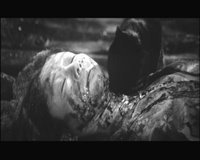 The samurai enter and steal their food and then the two women are gang raped. We see the samurai leave and then smoke begin to billow from the doorway, the hut is engulfed in a beautifully filmed inferno which eventually leaves nothing but a charred skeleton of a building with the two corpses blackened and bloodied. A black cat enters the ruins and begins to feed upon the blood from the corpses’ necks.
The samurai enter and steal their food and then the two women are gang raped. We see the samurai leave and then smoke begin to billow from the doorway, the hut is engulfed in a beautifully filmed inferno which eventually leaves nothing but a charred skeleton of a building with the two corpses blackened and bloodied. A black cat enters the ruins and begins to feed upon the blood from the corpses’ necks.
A samurai rides in the night, he seems almost asleep upon his horse, to the point that he doesn’t notice the white shape that jumps over him. He sees a young woman, we recognise as Shige, and she is scared of travelling through the bamboo grove alone. He offers to escort her. They reach her home and she offers him hospitality. Her mother, Yone, brings food and sake. There is a long conversation; much of it has a political overtone as the film is very concerned with the socio-dynamics of the rich and poor. However we note much as this occurs. At one point, behind her back, we see the mother’s hair swish like a cat’s tail, and often, through the bamboo grove and in the house, we hear a cat cry. We also hear that three years before, whilst tilling the fields, Yone’s son, Gintoki (Kichiemon Nakamura) was shanghaied into the war and has not been seen since.
He sees a young woman, we recognise as Shige, and she is scared of travelling through the bamboo grove alone. He offers to escort her. They reach her home and she offers him hospitality. Her mother, Yone, brings food and sake. There is a long conversation; much of it has a political overtone as the film is very concerned with the socio-dynamics of the rich and poor. However we note much as this occurs. At one point, behind her back, we see the mother’s hair swish like a cat’s tail, and often, through the bamboo grove and in the house, we hear a cat cry. We also hear that three years before, whilst tilling the fields, Yone’s son, Gintoki (Kichiemon Nakamura) was shanghaied into the war and has not been seen since. 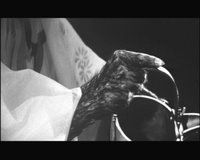 The mother leaves, being discrete Shige says before pouring more sake. For a moment her arm is that of a cat’s. The samurai blinks and, of course, it is just a girl’s arm. They end up in the curtained bed and, after some fumbling she bites into his throat. His body is found in the grove the next day.
The mother leaves, being discrete Shige says before pouring more sake. For a moment her arm is that of a cat’s. The samurai blinks and, of course, it is just a girl’s arm. They end up in the curtained bed and, after some fumbling she bites into his throat. His body is found in the grove the next day.
We’ll stop here a moment and look at the cat/ghost/vampire we are dealing with. Despite the neck bite it might not seem vampiric and yet the elements are familiar to the Western myths and strong within Japanese folklore. The story itself is, I believe, loosely based on the Japanese tale, “The Cat’s return”.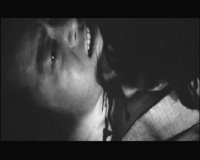 A google couldn’t find much about this but I am reminded also of the traditional tale, The Vampire Cat of Nabéshima, in fact, later in the film, we see a reflection of Yone in the water and the face is very much of a demonic cat. Cats are also very much a part of both traditional and literary Western vampire myth. In traditional myth one way a vampire could be created was for a black cat to leap over the corpse in its coffin. In Carmilla, the vampire is able to transform into a giant cat and often feeds in that form whilst sat on the victim’s chest.
A google couldn’t find much about this but I am reminded also of the traditional tale, The Vampire Cat of Nabéshima, in fact, later in the film, we see a reflection of Yone in the water and the face is very much of a demonic cat. Cats are also very much a part of both traditional and literary Western vampire myth. In traditional myth one way a vampire could be created was for a black cat to leap over the corpse in its coffin. In Carmilla, the vampire is able to transform into a giant cat and often feeds in that form whilst sat on the victim’s chest.
In this film we later discover that the two women have offered themselves to the evil Gods or spirits in order to exact their revenge.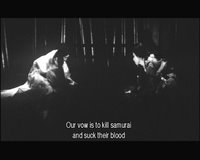 Their vow means they cannot reveal their true identities or why they have done this and must suck the blood of samurai. It becomes very apparent that the house is a construct, only seen by victims. It also becomes apparent, as the movie progresses, that there are various ways the vampires can be killed. To breach their vow will kill them, to recite an edifying sutra will put their soul to rest and it seems that the sword can kill them also. It seems that the women cannot be seen at dawn, though it is never explicitly said that the sun kills them, and this ties in with both vampiric and ghost traditions.
Their vow means they cannot reveal their true identities or why they have done this and must suck the blood of samurai. It becomes very apparent that the house is a construct, only seen by victims. It also becomes apparent, as the movie progresses, that there are various ways the vampires can be killed. To breach their vow will kill them, to recite an edifying sutra will put their soul to rest and it seems that the sword can kill them also. It seems that the women cannot be seen at dawn, though it is never explicitly said that the sun kills them, and this ties in with both vampiric and ghost traditions.
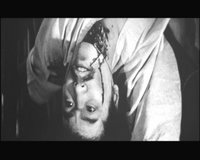 In the film we see a progression of Samurai killed by the women. Each kill sequence becomes shorter as this is a filmic device to show the destruction the women weave. One of the samurai becomes suspicious before he and Shige reach the house and he attacks her. She evades his sword with high leaps and kills him in the grove. Eventually the Mikado (Hideo Kanze) orders master samurai Raiko (Kei Sato) to deal with the situation.
In the film we see a progression of Samurai killed by the women. Each kill sequence becomes shorter as this is a filmic device to show the destruction the women weave. One of the samurai becomes suspicious before he and Shige reach the house and he attacks her. She evades his sword with high leaps and kills him in the grove. Eventually the Mikado (Hideo Kanze) orders master samurai Raiko (Kei Sato) to deal with the situation.
Raiko’s forces are at war and we cut to that battlefield. We see a hairy giant of a man with an iron club chasing a bedraggled man. They run through the rushes but the giant’s leg becomes stuck in a pothole. The man runs at him with a sword. We see him ride to Raiko and present the giant man’s head. He is Gintoki and he is bathed and given honour. He goes to his home and discovers that it is a burnt out shell, his mother and wife are missing and then he is given the task of destroying the monster which kills samurai by tearing out their throats.
He meets Shige, who hides her face bashfully and, when they reach the house, does not invite him in. However he asks for entry to rest and has seen her face and we see a moment of almost recognition. In the house he recognises the two women but cannot reconcile their new clothes and home with his family. He eventually asks them outright but they cannot answer. The rest of the film concerns his struggle to decide whether they are his family, or evil spirits who have taken their guise, his love for his wife and his struggle with the need to be with his family and to destroy the monsters for his master.
The film is beautifully shot, the bamboo used to give elements of motion where no motion exists. It is difficult to explain just how beautiful some of the cinematography is and screenshots do not do it justice, it has to be seen in motion to fully appreciate.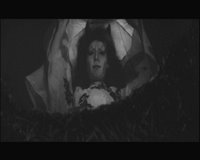 The film is filled with imagery that will stay with the viewer long after watching. It is also wonderfully acted, although that acting can seem rather stagey at times as there are elements that are almost kabuki in nature.
The film is filled with imagery that will stay with the viewer long after watching. It is also wonderfully acted, although that acting can seem rather stagey at times as there are elements that are almost kabuki in nature.
The soundtrack is perfect for the piece stirring when needed, beautifully romantic at the right times. The film is, most definitely, a masterwork that explores tragedy, horror, honour and politics. The twenty four page booklet, which comes with the Masters of Cinema edition DVD, explains to us that in Japanese culture, as well as being a supernatural icon, the cat “resembles the lower classes of medieval Japanese society abused by the nobles and the samurai.” As such we end with the question, are these vengful vampire spirits evil or actually heroes?
This is an unusual vampire film but it is also a wonderful vampire film with a fantastically downbeat ending that you must see the film to experience. 8.5 out of 10.
The imdb page is here.
Directed by: Kaneto Shindô
Contains spoilers
This film is a Japanese offering from 1968 and is an astonishing piece of cinema with an unusual vampiric element. Though the film is very much about vengeful spirits and, I know, that some have questioned whether it is actually a vampire movie it most definitely is – though being from a different tradition than your atypical Eastern European vampire the resulting rules are very different and yet eerily familiar.
The film begins with a hut and a group of samurai emerging from the trees; they are bedraggled, wild looking and lap greedily at the stream by the hut. Inside the hut are two women, we later discover to be Yone (Nobuko Otowa) and her daughter-in-law Oshiga or Shige (Kiwako Taichi) as she is more familiarly known.
 The samurai enter and steal their food and then the two women are gang raped. We see the samurai leave and then smoke begin to billow from the doorway, the hut is engulfed in a beautifully filmed inferno which eventually leaves nothing but a charred skeleton of a building with the two corpses blackened and bloodied. A black cat enters the ruins and begins to feed upon the blood from the corpses’ necks.
The samurai enter and steal their food and then the two women are gang raped. We see the samurai leave and then smoke begin to billow from the doorway, the hut is engulfed in a beautifully filmed inferno which eventually leaves nothing but a charred skeleton of a building with the two corpses blackened and bloodied. A black cat enters the ruins and begins to feed upon the blood from the corpses’ necks.A samurai rides in the night, he seems almost asleep upon his horse, to the point that he doesn’t notice the white shape that jumps over him.
 He sees a young woman, we recognise as Shige, and she is scared of travelling through the bamboo grove alone. He offers to escort her. They reach her home and she offers him hospitality. Her mother, Yone, brings food and sake. There is a long conversation; much of it has a political overtone as the film is very concerned with the socio-dynamics of the rich and poor. However we note much as this occurs. At one point, behind her back, we see the mother’s hair swish like a cat’s tail, and often, through the bamboo grove and in the house, we hear a cat cry. We also hear that three years before, whilst tilling the fields, Yone’s son, Gintoki (Kichiemon Nakamura) was shanghaied into the war and has not been seen since.
He sees a young woman, we recognise as Shige, and she is scared of travelling through the bamboo grove alone. He offers to escort her. They reach her home and she offers him hospitality. Her mother, Yone, brings food and sake. There is a long conversation; much of it has a political overtone as the film is very concerned with the socio-dynamics of the rich and poor. However we note much as this occurs. At one point, behind her back, we see the mother’s hair swish like a cat’s tail, and often, through the bamboo grove and in the house, we hear a cat cry. We also hear that three years before, whilst tilling the fields, Yone’s son, Gintoki (Kichiemon Nakamura) was shanghaied into the war and has not been seen since.  The mother leaves, being discrete Shige says before pouring more sake. For a moment her arm is that of a cat’s. The samurai blinks and, of course, it is just a girl’s arm. They end up in the curtained bed and, after some fumbling she bites into his throat. His body is found in the grove the next day.
The mother leaves, being discrete Shige says before pouring more sake. For a moment her arm is that of a cat’s. The samurai blinks and, of course, it is just a girl’s arm. They end up in the curtained bed and, after some fumbling she bites into his throat. His body is found in the grove the next day.We’ll stop here a moment and look at the cat/ghost/vampire we are dealing with. Despite the neck bite it might not seem vampiric and yet the elements are familiar to the Western myths and strong within Japanese folklore. The story itself is, I believe, loosely based on the Japanese tale, “The Cat’s return”.
 A google couldn’t find much about this but I am reminded also of the traditional tale, The Vampire Cat of Nabéshima, in fact, later in the film, we see a reflection of Yone in the water and the face is very much of a demonic cat. Cats are also very much a part of both traditional and literary Western vampire myth. In traditional myth one way a vampire could be created was for a black cat to leap over the corpse in its coffin. In Carmilla, the vampire is able to transform into a giant cat and often feeds in that form whilst sat on the victim’s chest.
A google couldn’t find much about this but I am reminded also of the traditional tale, The Vampire Cat of Nabéshima, in fact, later in the film, we see a reflection of Yone in the water and the face is very much of a demonic cat. Cats are also very much a part of both traditional and literary Western vampire myth. In traditional myth one way a vampire could be created was for a black cat to leap over the corpse in its coffin. In Carmilla, the vampire is able to transform into a giant cat and often feeds in that form whilst sat on the victim’s chest.In this film we later discover that the two women have offered themselves to the evil Gods or spirits in order to exact their revenge.
 Their vow means they cannot reveal their true identities or why they have done this and must suck the blood of samurai. It becomes very apparent that the house is a construct, only seen by victims. It also becomes apparent, as the movie progresses, that there are various ways the vampires can be killed. To breach their vow will kill them, to recite an edifying sutra will put their soul to rest and it seems that the sword can kill them also. It seems that the women cannot be seen at dawn, though it is never explicitly said that the sun kills them, and this ties in with both vampiric and ghost traditions.
Their vow means they cannot reveal their true identities or why they have done this and must suck the blood of samurai. It becomes very apparent that the house is a construct, only seen by victims. It also becomes apparent, as the movie progresses, that there are various ways the vampires can be killed. To breach their vow will kill them, to recite an edifying sutra will put their soul to rest and it seems that the sword can kill them also. It seems that the women cannot be seen at dawn, though it is never explicitly said that the sun kills them, and this ties in with both vampiric and ghost traditions. In the film we see a progression of Samurai killed by the women. Each kill sequence becomes shorter as this is a filmic device to show the destruction the women weave. One of the samurai becomes suspicious before he and Shige reach the house and he attacks her. She evades his sword with high leaps and kills him in the grove. Eventually the Mikado (Hideo Kanze) orders master samurai Raiko (Kei Sato) to deal with the situation.
In the film we see a progression of Samurai killed by the women. Each kill sequence becomes shorter as this is a filmic device to show the destruction the women weave. One of the samurai becomes suspicious before he and Shige reach the house and he attacks her. She evades his sword with high leaps and kills him in the grove. Eventually the Mikado (Hideo Kanze) orders master samurai Raiko (Kei Sato) to deal with the situation.Raiko’s forces are at war and we cut to that battlefield. We see a hairy giant of a man with an iron club chasing a bedraggled man. They run through the rushes but the giant’s leg becomes stuck in a pothole. The man runs at him with a sword. We see him ride to Raiko and present the giant man’s head. He is Gintoki and he is bathed and given honour. He goes to his home and discovers that it is a burnt out shell, his mother and wife are missing and then he is given the task of destroying the monster which kills samurai by tearing out their throats.
He meets Shige, who hides her face bashfully and, when they reach the house, does not invite him in. However he asks for entry to rest and has seen her face and we see a moment of almost recognition. In the house he recognises the two women but cannot reconcile their new clothes and home with his family. He eventually asks them outright but they cannot answer. The rest of the film concerns his struggle to decide whether they are his family, or evil spirits who have taken their guise, his love for his wife and his struggle with the need to be with his family and to destroy the monsters for his master.
The film is beautifully shot, the bamboo used to give elements of motion where no motion exists. It is difficult to explain just how beautiful some of the cinematography is and screenshots do not do it justice, it has to be seen in motion to fully appreciate.
 The film is filled with imagery that will stay with the viewer long after watching. It is also wonderfully acted, although that acting can seem rather stagey at times as there are elements that are almost kabuki in nature.
The film is filled with imagery that will stay with the viewer long after watching. It is also wonderfully acted, although that acting can seem rather stagey at times as there are elements that are almost kabuki in nature.The soundtrack is perfect for the piece stirring when needed, beautifully romantic at the right times. The film is, most definitely, a masterwork that explores tragedy, horror, honour and politics. The twenty four page booklet, which comes with the Masters of Cinema edition DVD, explains to us that in Japanese culture, as well as being a supernatural icon, the cat “resembles the lower classes of medieval Japanese society abused by the nobles and the samurai.” As such we end with the question, are these vengful vampire spirits evil or actually heroes?
This is an unusual vampire film but it is also a wonderful vampire film with a fantastically downbeat ending that you must see the film to experience. 8.5 out of 10.
The imdb page is here.

















2 comments:
I just watched the Criterion edition of this the other day. I fully expected this to be "Vamp or Not?" though I am in agreement that it is certainly vamp. I preferred "Kuroneko" over Kaneto Shindō's "Onibaba," which is always mentioned as a horror film for some reason.
I don't really know why I didn't go 'Vamp or Not?' - probably because I was so sold on its vampness as I watched it, a great film... glad you enjoyed it Derek
Post a Comment